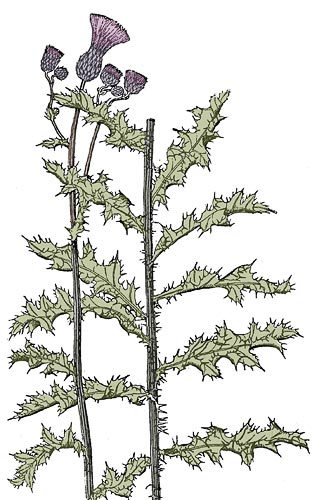Weeds
Cirsium arvense (L.) Scop. - Field Thistle.
Synonyms.
Serratula arvensis L., Cirsium arvense var. horridum Koch.Systematic position.
Family Asteraceae (Compositae), genus Cirsium Hill, subgenus Breea (Less.) Tzvel.Biological group.
Summer-green perennial plant that forms offshoots.Morphology and biology.
Root system is well-developed. It consists of a main stalk root and numerous horizontal, lateral rhizomes, which generate new stalks. Stalk is 45-70 cm in height, upright, ramified, striated or costate, more often with glabrous or cobwebby pubescence under calathidia. Phyllotaxy alternate. Leaves are rather coarse, yellow-green, sedentary or short-petiolate, oblong or lanceolate, deeply sinuate, pinnatilobate to pinnatipartite, repand-curly, glabrous or (less often) cobwebby pubescent on the bottom, up to 20 cm in length and 5-6 cm in width, with strong edge thorns 3-5 (6) mm in length. Leaves form small, prickly wings or a line of thorns on stalk. It is a dioecious plant. Female pistillate flowers are located in some calathidia, and male staminate flowers in others. Flowers are unisexual due to insufficient development of either pestles or stamens. Color of flowers is lilac, rose, pink, or purple. Limbus of corolla is pentamerous with lobes separated from base. The limbus is several times shorter than tube of corolla, usually 2 times shorter in staminate flowers and 4-5 times shorter in pistillate flowers. Anthers at the base have apically jagged appendages; staminal filaments are glabrous. Floral calathidia are small (1-2 cm in diameter), always upright on cobwebby stalks, gathering in paniculate inflorescence. Receptacle flat with long bracts. Involucre cup-shaped or oblong. Leaflets of involucre are pluriserial, imbricate, pubescent with small, coarse hairs from outside, covered with weak and short albesent setae along edges. External leaflets are purple-violet, with short thorn at the top; internal leaflets are lengthened, scarious at the top. Fruit is oblong yellowish or brownish hemicarp with indistinct longitudinal grooves, 3 mm in length, squeezed laterally, glabrous, with long fragile pappus consisting of plumose hairs. Pappus is dirty white and upon flowering is shorter than nimbus; by the end of flowering, it extends almost 3 times longer than nimbus during fruiting. One plant produces up to 4000 seeds. Reproduction by seeds and cloning (root offspring). Blossoming occurs from middle of June until the time of frost. Seeds ripen in September and October.Distribution.
The species is distributed in Western and now Eastern Europe and has been introduced to North America. The original area is European and Western Asian. In Russia, it is distributed in the European part (Baltic, Ladoga-Ilmen, Upper-Dnepr, and Carpathian areas) and in the Caucasus. In the Far East, it is an adventive plant.Ecology.
This ruderal weed grows in rubbish heaps, along roads, in settlements, in waste grounds and along railways; it also contaminates crops. It is distributed throughout mixed and broad-leaved forests, as well as in steppes. Xero- and mesophyte; meadow-steppe species.Economic significance.
Honey plant. Above-ground parts of Field Thistle are used in non-traditional medicine. It is a malicious weed of not-irrigated agriculture that is hard to eradicate, ruderal and segetal. It is one of the main weeds of fields and meadows in Western European Russia, in the Carpathian mountains, Transcarpathia, and Transcaucasia. As for control measures, it is necessary to regularly destroy rhizomes of the thistle with the help of appropriate types of soil treatment and herbicides, to avoid contamination of sowing material or ground by seeds of the thistle, and to mow off or pull up the weed before fructification.Related references.
Maltsev, A.I. 1937. Atlas of the major species of weed plants of the USSR. Moscow - Leningrad: Selkhosgiz. V.1. 168 pp. (in Russian).Nikitin, V.V. 1983. Weed plants of the USSR flora. Leningrad: Nauka. 454 pp. (in Russian).
Kharkevitch, S.S., ed. 1992. Vascular plants of the Soviet Far East. Saint-Petersburg: Nauka. V.6. 428 pp. (in Russian).
Takhtadzhyan, A.L. & Fedorov, A.A. 1972. Flora of Erevan. Leningrad: Nauka. 396 pp. (in Russian).
Karyagin I.I. ed. 1961. Flora of Azerbaijan. Baku: AN AzSSR. V.8. 690 pp. (in Russian).
Tolmachev, A.I., ed. 1974. Keys to higher plants of Sakhalin and Kurile islands. Leningrad: Nauka. 372 pp. (in Russian).


